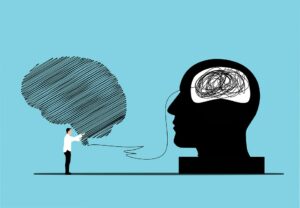Pure OCD, also known as Primarily Obsessional OCD, is a type of OCD that is characterized by intrusive thoughts and images that are disturbing and cause a great deal of anxiety. These thoughts can be about anything, but often involve harm coming to oneself or others. People with this condition may engage in compulsive behaviors in an attempt to neutralize the thoughts or get rid of them altogether. If you think you may have Pure obsessive OCD, it is important to seek help from a mental health professional. In this blog post, we will discuss the symptoms of Pure OCD and how it can be treated.
Contents
Pure OCD Obsession And Compulsion
In Pure O OCD people suffer from obsessive thoughts and compulsive behaviors which are:
Compulsion: People with pure O OCD often engage in compulsive behaviors like repeatedly checking locks and windows, or excessively washing their hands. Compulsive behaviors are typically used as a way to try and reduce the anxiety associated with these thoughts. Feeling guilty and avoiding are common signs of compulsions.
Obsession: Intrusive thoughts are recurrent and unwanted in Pure OCD, but unlike other types of OCD there is usually no outward expression of the obsessions. Examples of this include fear of doing something wrong or an irrational fear that someone will be hurt.
The Symptoms Of Pure OCD

The most common signs or symptoms of Pure O OCD include:
- Recurrent intrusive thoughts – These can be about anything, including harm coming to oneself or others.
- Obsessive compulsive behaviors – These behaviors are designed to help control or stop intrusive thoughts. Examples include extreme handwashing, examining body parts for injury or illness, or repeatedly checking locks and windows.
- Avoidance – People with Pure OCD often engage in avoidance behavior to try and prevent the intrusive thoughts from returning. This can lead to a decrease in quality of life as they may become isolated or unable to perform their normal tasks.
- Anxiety – Intrusive thoughts are typically accompanied by intense anxiety.
- Depression – Over time, the avoidance behavior can lead to depression as people feel they are unable to control their intrusive thoughts.
Causes Of Pure OCD
There is not any strong cause of this form of OCD; however, it is possible that certain factors can contribute to the development of this condition. These include:
Genetics – Studies have shown a genetic link between Pure OCD and other forms of anxiety disorders such as generalized anxiety disorder, panic disorder, and social anxiety disorder.
Brain chemistry – Abnormal levels of serotonin in the brain may, in some cases, lead to this rare form of OCD.
Family History With OCD: Having a family member with OCD may increase the likelihood of developing this condition.
Environmental Factors– Traumatic life events such as a death in the family, physical or sexual abuse, and bullying may contribute to the development of this rare condition of OCD. Experiencing traumatic events or long periods of stress can trigger this Pure form of OCD.
The Difference Between Pure OCD And OCD
The main difference between Pure O OCD and traditional OCD is that the intrusive thoughts in Pure obsessive disorder are not directly related to compulsive behavior and it is a sub-type of it. With traditional OCD, there is usually an element of fear or anxiety associated with the obsessions that lead to compulsions. For example, someone with traditional OCD may obsessively fear germs and be compelled to wash their hands multiple times a day. In contrast, someone with this type of OCD may obsessively fear that they are going to hurt someone. Along with it not have any compulsive behavior associated with this thought.
How Is Pure OCD Diagnosed?

Pure obsessive OCD is diagnosed based on a person’s symptoms and history. A mental health professional will ask questions about your symptoms, behavior patterns, and thoughts in order to make a diagnosis. Your doctor may also use tests such as the Yale-Brown Obsessive Compulsive Scale or structured interviews like the Structured Clinical Interview for DSM Disorders to help with the diagnosis. The DSM 5 is the primary diagnostic manual for mental health professionals. It is used to diagnose various conditions, including this form of OCD.
How To Treat Pure OCD Condition?

Here are some methods to deal with this sub-type of OCD condition:
Psychotherapy
- Cognitive Behavioral Therapy (CBT): CBT is a form of psychotherapy that focuses on changing the thoughts and behavior associated with Pure OCD. It helps people to identify negative patterns of thought and replace them with more positive ones.
- Mindfulness-based CBT: It is a part of this CBT therapy. This is an effective way to manage this condition by focusing on patience, acceptance, and understanding.
- Exposure and response prevention (ERP): It is a type of behavioral therapy that helps people learn how to manage the intrusive thoughts associated with Pure OCD. During ERP, people are exposed to their fear or obsession in a safe environment. Afterward taught how to cope with it without engaging in compulsive behavior.
Medication
Antidepressant medications such as selective serotonin reuptake inhibitors (SSRIs) can help reduce symptoms of Pure OCD and can be used in conjunction with psychotherapy. Other medications, such as antipsychotics or anti-anxiety medications are also be prescribed for short-term use.
Exercises
Exercises are the great way to help manage Pure OCD. Regular aerobic exercise releases endorphins and other hormones that reduce stress and anxiety, which can help reduce symptoms of this type of OCD. Other types of exercise, such as yoga or meditation, can also be beneficial.
Mindful Activities
Mindful activities, such as coloring or drawing, can help to focus the mind on something else and reduce the intensity of intrusive thoughts. Spending time in nature can also be a helpful way to reduce symptoms of this OCD pure condition. Taking a break from technology and spending time with friends and family can also help manage this condition. Listen to music, read books, watch movies, and do other activities that can help you relax. Making lifestyle changes to reduce stress, such as getting more sleep, engaging in regular exercise, and eating a healthy diet, can be beneficial for people with Pure OCD. It is also important to practice good self-care habits. It includes setting realistic goals, communicating openly with friends and family, and taking breaks when needed.
Support Groups
Support groups can be a helpful way to connect with other people who have Pure OCD. Joining a support group can help alleviate feelings of loneliness and provide individuals with guidance, tips, and resources. All of these activities would be helpful to manage their symptoms.
Finally, it is important to remember that this type of OCD is treatable, and recovery is possible. People with this type of OCD can learn how to manage their symptoms and live more fulfilling lives by following an appropriate treatment plan.
Conclusion
Pure OCD is a condition that manifests itself in intrusive thoughts and behaviors that can cause distress and anxiety. While there is no definitive cause of this condition, it is likely the result of genetic and environmental factors. Treatment for this condition usually involves psychotherapy and medication. In addition, exercise and mindfulness-based therapies can be effective in managing this condition.
Take care, and don’t forget that you are not alone! OCD is a mental health disorder characterized by obsessions and compulsions. If you have any queries regarding OCD treatment, ERP therapy experienced therapists at OCDMantra can help: Book a trial OCD therapy session


